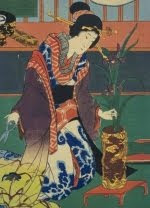Earlier this year I posted a note about a performance by ikebana artist Shuhô in the Portland Japanese Garden. I was happy to find her again on YouTube with a performance video from Palais de Tokyo in Paris. This performance was part of the exhibition 100 ans plus tard (100 years later) and was held at the opening June 5th.
Shuhô who has studied early ikebana styles from the Muromachi period (1336 - 1573), became the first Master of Ikebana studies at Ginkaku-ji, the Silver Pavilion in Kyoto, in 2004. She has been promoting international exchanges through ikebana and the Zen arts worldwide. She is also in charge of programs and organization of Jisho-ji workshop Dojo founded at Ginkaku Jishô-ji in 2011. This study centre, open to the different artistic disciplines of Zen culture, has attracted a younger generation and brought a new boast to a long tradition that considers the shogun Ashikaga Yoshimasa (1436-1490), who built the Silver Pavilion and retired there to cultivate the traditional art, as the father of ikebana.
In 2013 Shuhô was invited by The Pavillon Neuflize OBC, the Palais de Tokyo’s creative laboratory, to collaborate on a project with the residents of the 2013-2014 program. The exhibition 100 ans plus tard is the result of these exchanges bringing together traditional practices and the contemporary arts. There will also be with a second presentation in Japan in the fall.
Ikebana became 'the common experimenting ground on which mutual translation procedures were tested out—between languages, geographic and cultural zones, and between periods and practices—as a means of bypassing the exotic approach. The definition of a space, symbolized by the importance given to the vase in ikebana, has become one of the central elements of this collective experience. The vase is the tool of transmission and negotiation between the inside and the outside, between states (solid, liquid, gaseous) and between the elements of the composition. “In ikebana,” says Shuhô, “when we gaze at a composition, we must pay attention to the mizugiwa [the edge of the water].” The exhibition is a container in which the artworks are reflected—a puddle of water in which, 100 years later, the forgotten memories of gestures, opinions and objects will still shimmer.'
As part of the exchange the participating artists have been invited to a work session in Kyoto, at the Ginkaku Jishô-ji. I wonder what they were talking about in the Dojo of the Silver Pavilion? We'll probably never know, but you can see some photos from the workshops through this link.
If you understand Japanese you might be interested to look at this video with Shuho giving a demonstration in a Tokyo bookshop.












No comments:
Post a Comment